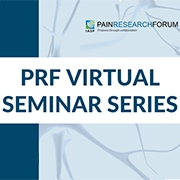Editor’s note: This is the sixth in a series of weekly PRF seminars to help keep the pain research community connected during the COVID-19 pandemic and to provide all members of our community with virtual educational opportunities. The seminar series is supporter by the Center for Advanced Pain Studies at the University of Texas at Dallas, US, and this particular seminar is also supported by Cellectricon. We thank both for their generous support.
The IASP Pain Research Forum hosted a seminar with Kieran Boyle, PhD, University of Glasgow, UK, and Tyler Nelson, PhD candidate, University of Pittsburgh, US, on Monday, June 8, 2020, noon–1 p.m. Eastern Daylight Time (US)/ 5-6 p.m. BST/ 6-7 p.m. CEST. A Q&A session moderated by Reza Sharif-Naeini, PhD, McGill University, Montreal, Canada, followed the presentations.

- Kieran Boyle, University of Glasgow, UK
- Tyler Nelson, University of Pittsburgh, US
- Reza Sharif-Naeini, McGill University, Montreal, Canada
A recording of this seminar will soon be freely available to IASP members at the IASP Pain Education Resource Center (PERC).
Here are abstracts from the presenters
Title: Neuropeptide Y-Expressing Dorsal Horn Inhibitory Interneurons in Spinal Pain and Itch Circuits (presented by Kieran Boyle)
Previous studies have implicated inhibitory interneurons of the spinal dorsal horn (SDH) that exhibit transient developmental and/or adult expression of neuropeptide Y (NPY) in suppression of mechanical itch. We used intraspinal injection of adeno-associated viruses that express Cre-dependent constructs into adult NPY::Cre (RH26) mice to assess the effects of activity manipulation specifically targeted to interneurons that express NPY in the adult SDH (NPY-INs). We find that this method reliably targets the majority of NPY-INs in the adult SDH, while avoiding those that transiently express NPY. Chemogenetic activation of NPY-INs resulted in increased mechanical and thermal nociceptive thresholds and reduced chloroquine-induced itch behavior, as well as reduced cFos expression in the SDH in response to noxious thermal or pruritic stimuli. Chemogenetic activation of NPY-INs also blocked the punctate mechanical and thermal hypersensitivity normally observed in the complete Freund’s adjuvant and spared nerve injury models of inflammatory or neuropathic pain. Silencing NPY-INs with tetanus toxin light chain resulted in both spontaneous itching behavior and an exaggerated itch response to chloroquine, but had no significant effect on acute mechanical or thermal nociceptive thresholds. Based on these results, we conclude that NPY-INs are able to supress activity in SDH circuits that process and transmit pain- and itch-related information in both normal and pathological conditions, and that tonic NPY-IN activity is required to set normal itch thresholds. Dorsal horn NPY-INs therefore represent a potential target for treatment of acute and/or pathological pain and itch.
Title: Targeting Spinal Neuropeptide Y1 Receptor-Expressing Interneurons to Alleviate Neuropathic Pain (presented by Tyler Nelson)
Neuropeptide Y (NPY) in the spinal cord dorsal horn exhibits long-lasting inhibitory control of nociceptive transmission after injury. The specific receptor targets of NPY in the spinal cord have not been well characterized, particularly in the setting of neuropathic pain. We find that intrathecal administration of a selective Y1 receptor agonist dose-dependently reduces both behavioral symptoms of pain and immunohistochemical expression of markers of central sensitization following peripheral nerve injury. Additionally, knockout of Y1 receptors from the primary afferents does not alter the Y1 agonist-induced antihyperalgesia. Therefore, following traumatic nerve injury, dorsal horn neurons that express the neuropeptide Y1 receptor (Y1-INs), an inhibitory G protein-coupled receptor, likely mediate the antinociceptive actions of NPY. Using in vivo chemogenetics, we demonstrate that Y1-INs are both necessary and sufficient for the manifestation of peripheral nerve injury-induced mechanical and cold hypersensitivities. Additionally, we began to characterize Y1-INs using fluorescence in situ hybridization for non-overlapping markers of excitatory spinal interneurons to begin to isolate distinct Y1-IN subpopulations.
About the presenters
Kieran Boyle, PhD, graduated with his MSci in neuroscience from the University of Glasgow in 2004, having been taught by many of the people he now works alongside. He then moved to London to pursue a Wellcome Trust 4-Year PhD in Neuroscience at University College London in the laboratories of Prof. Patricia Salinas and Prof. Alasdair Gibb, using a combination of confocal imaging and electrophysiology to investigate the role of Wnt signalling in hippocampal synapse formation and function. Following a short post-doc in the Salinas lab, he returned to the University of Glasgow in 2012 to join the Spinal Cord Group, where he has remained since. His work in the laboratories of Prof. Andrew Todd and Dr. David I. Hughes has centered on spinal cord circuits involved in pain, itch and tactile processing.
Tyler S. Nelson, BS/BA, graduated with an BS in biology and BA in German with concentrations in neuroscience and medical humanities from Wofford College in Spartanburg, SC, in 2016. Previously, he worked in neural circuits of taste in the laboratories of Drs. Dave Pittman and John P. Baird at Wofford and Amherst Colleges. He is currently a PhD candidate in the laboratory of Dr. Bradley Taylor in the Center for Neuroscience and a trainee in the Pittsburgh Center for Pain Research and Center for the Neural Basis of Cognition at the University of Pittsburgh, PA, US. His research utilizes in vivo chemogenetics/optogenetics, pharmacology, immunohistochemistry, and in situ hybridization to investigate microcircuitry of the spinal cord dorsal horn and how neuropathic injury leads to maladaptive changes in sensory processing.
About the moderator
Reza Sharif-Naeini, PhD, joined the faculty of McGill University, Canada, in 2012 and is currently associate professor in the Department of Physiology. He received his PhD from the same university in 2007, working with Dr. Charles Bourque (Centre for Research in Neuroscience). He then completed postdoctoral fellowships in ion channel physiology (funded by the Human Frontier Science Program) with Dr. Eric Honoré at the Institut de Pharmacologie Moleculaire et Cellulaire (France) and in pain genetics and circuitry (funded by IASP and the Canadian Institutes of Health Research, CIHR) with Dr. Allan Basbaum at the University of California, San Francisco. Dr. Sharif-Naeini’s research focuses on the role of ion channels in the sensation of pain, as well as the spinal neuronal networks involved in the processing of sensory information in the spinal cord. Both aspects are examined under control and chronic pain conditions. He uses a wide range of techniques from molecular biology to electrophysiology and behavioral assays to elucidate these mechanisms. His research is supported by local (the Alan Edwards Centre for Research on Pain), Provincial (Fonds de Recherche du Quebec), and federal agencies (National Science and Engineering Research Council of Canada and the CIHR). When not doing science or shoveling snow in the Montreal winter, Dr. Sharif-Naeini spends time with his family, gardening, and enjoying a fine single malt whiskey from time to time.
Join the conversation about the seminar on Twitter @PainResForum #PRFSeminar
We thank the Center for Advanced Pain Studies at the University of Texas at Dallas, US, and Cellectricon, Mölndal, Sweden, for their support of this seminar.



